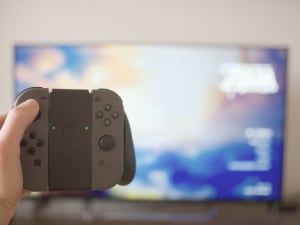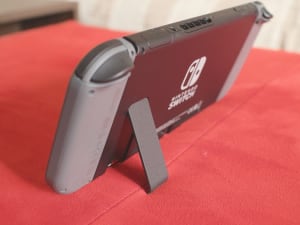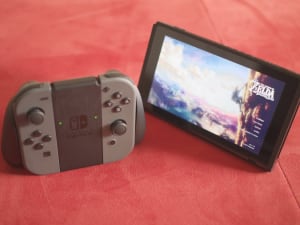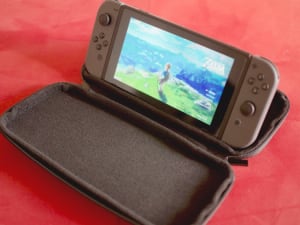Nintendo Switch: The perfect console for digital nomads
published on
Deian has been a gamer for as long as he can remember. But times change and your time to play grows shorter and shorter. Thankfully, a Japanese company has found a solution with the Nintendo Switch.
Deian was a young lad when he read about the Nintendo 64 in a magazine. His friends already had the Super Nintendo Entertainment System (SNES) at the time but a new console was on the horizon; one that promised breath-taking 3D graphics — it was a major step up from what was known at the time.
Growing up, Deian played a lot in his free-time — you just have a lot of it as a kid. But the older you get, the more you have to carefully plan every minute of your day. Gaming has become a hobby he tries to do every day but rarely succeeds.
Meet the Nintendo Switch
When rumours about a hybrid console came to light, nobody wanted to really believe them. But it all made sense: Nintendo had been struggling to put out enough games for two systems: a handheld (Nintendo 3DS) and a home console (Wii U). The next major step was to build something that is powerful enough for home console gaming but can be taken on the go without sacrificing graphical fidelity.
Meet the Nintendo Switch.
First shown on October 20th, 2016, this hybrid console is powered by a custom Nvidia Tegra Chip, Joy-Con controllers with advanced motion sensors and HD rumble and a USB-C-Connector. The console is accompanied by a dock, which provides a connection between the system and a TV.
Digital nomads, travellers, location independent workers and other people, who are mostly away from home, will appreciate the simplicity of taking this console on the go.
But first, let’s take a look at some hardware features:
| Nintendo Switch hardware details | |
|---|---|
| Screen | 6.2-inch / multi-touch capacitive touch screen / 1,280 × 720 |
| Storage | 32 GB internal flash memory / expandable with microSDHC or microSDXC cards |
| Weight | .88 lbs (399 g) with Joy-Con controllers |
| Networking | 802.11 a/b/g/n/ac / Bluetooth 4.1 |
| Resolutions | 720p built-in screen / 1080p docked |
| Audio | Stereo speakers / 5.1 Linear PCM |
| Headphone jack | 3.5 mm |
| Battery life | 2.5 — 6.5 hours |
Switch and play: The different gaming modes
Nintendo designed the Switch with one thing in mind: take it wherever, whenever and play however you like. This is the reason the Nintendo Switch is, for us and like-minded people, the perfect gaming system. We don’t stay in one place for too long; sometimes we don’t even have access to a TV. With the Nintendo Switch, you can play anytime, anywhere you like.
You basically have three possibilities:
1. Docked mode
Nintendo touts the Switch as a home console. To support this claim, the console has a rather simple dock which houses a USB-C connector, three USB-B ports (1× USB 2.0, 2× USB 3.0) and of course a HDMI port. The dock is naturally connected to the power outlet and allows the Nintendo Switch to run at full speed. Many games operate at higher resolutions when the Switch is sitting in the dock, for example, The Legend of Zelda: Breath of the Wild puts out a 900p signal docked but runs at 720p undocked (in handheld mode).

The biggest benefit of playing in docked mode, besides the higher resolution, is the fact that the console is charging. If you attach the Joy-Cons to the Switch unit, they’re also charged. Essentially, you can charge and play at the same time if you have another controller, for example, a Nintendo Switch Pro Controller.
But for us digital nomad gamers, the docked mode is something we will rarely enjoy. We usually game on the go and are quite happy when, from time to time, we can play Zelda in all its glory on the big screen.
2. Tabletop mode
Deian’s most favourite mode is tabletop. The Nintendo Switch has a kickstand on its back. It allows you to de-attach the Joy-Cons, put them in the grip and play looking at the 6.2-inch Display, wherever you are. This works really well on a plane or any other place with a table. Bus rides are another story: They are often very bumpy and the system tends to fall over.

Another cool thing about tabletop mode is the opportunity for co-op and multiplayer: Games like SnipperClips are best enjoyed with many players; the same goes for Mario Kart 8 Deluxe or Fast RMX. And: The Nintendo Switch is, out of the box, a system that can be enjoyed by two people. Hand your friend a Joy-Con and battle it out in Mario Kart 8 Deluxe or race to the finish line in Fast RMX.

Naturally, you can enjoy other games in tabletop mode that are played exclusively using the touchscreen. In VOEZ, for example, you put the console down and you can start playing immediately without the need of the kickstand.
Alina is more of a casual gamer so we decided to choose SnipperClips as our co-op game. Basically, you control two little personas that can cut each other out into different shapes; those help you reach your goal in different levels:
- carrying a pencil to the pencil sharpener
- throwing a basket ball into the hoop
Games like this and the possibility for multiplayer on the go without having to buy tonnes of controllers really sets the Switch apart. We can’t wait to meet other people and play with them SnipperClips and other games.
3. Handheld mode
If you’ve been a fan of handheld devices like the Nintendo DS family, the third mode will tickle your fancy. With the two Joy-Con controllers attached to the side, the Nintendo Switch is basically a big handheld. But the device remains comfortable, it’s comparable with the Wii U Gamepad but instead it’s a much sleeker device that not only looks great but also has a premium feel to it.

In handheld mode, you can play your favourite games in any position you like: sitting, on your back or even on your belly. If the bus ride is especially bumpy, you should play this way.
Nintendo Switch Accessories for travellers
When we pre-ordered the Nintendo Switch, we picked two accessories every digital nomad needs: a screen protector and a travelling case.

Because we decided to go with the official Nintendo Switch case, we didn’t need a separate screen protector because one was already included — or so we thought. Sadly, the screen protector is one of the cheaper ones and not a high-quality protector made from glass. In the meantime, we ordered one of those.
The travelling case itself is pretty solid: You can put the Nintendo Switch with the Joy-Cons attached into the case. Besides the main unit and its controllers, there is enough room for a small cloth and some games.
Another cool thing about this case is the stand: Yes, the Nintendo Switch already has one but this one is much more sturdy and allows you to play games even during a bumpy bus ride.

If you do not travel like us only with the Nintendo Switch and the grip but also with the dock, you might want to look into getting a bigger travelling case or a backpack. There already are a few official travel accessories available. We simply do not have the space for the dock because we travel with one bag only. Also, if you go digital, don’t forget to buy a microSD card (aim for at least 64 GB).
Final thoughts
The Nintendo Switch is a solid console that has given us a lot of joy since it launched. We can’t wait for more games to come out and make use of all the cool feature this hybrid console has to offer.